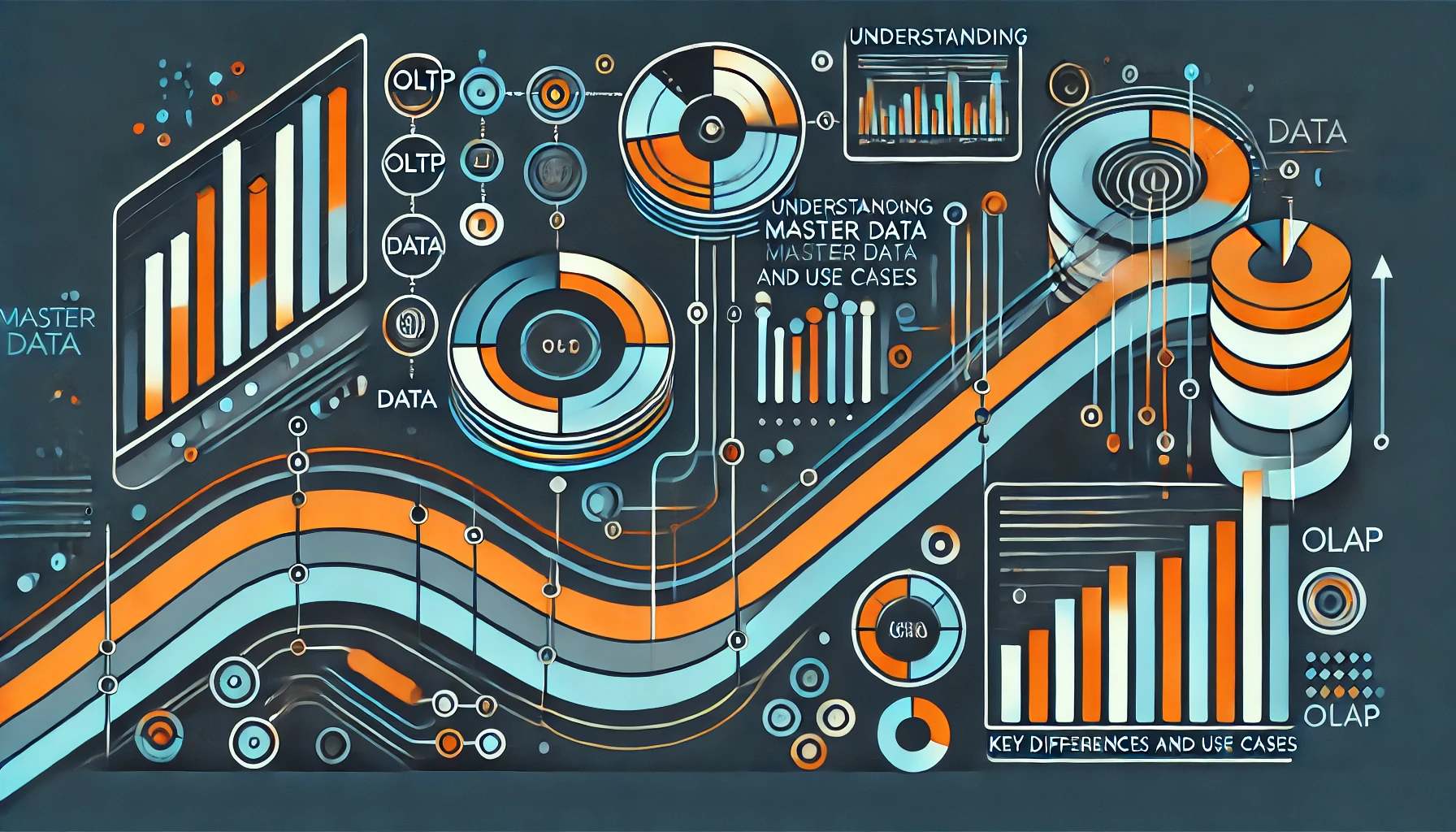Understanding OLTP, Master Data, and OLAP: Key Differences and Use Cases
 Eklemis Santo Ndun
Eklemis Santo Ndun
In the realm of data management and processing, terms like OLTP, Master Data, and OLAP frequently surface. While they are interconnected in the data ecosystem, each serves a distinct purpose. This article aims to demystify these concepts, compare their functionalities, and illustrate how they fit into the broader context of data systems.
Table of Contents
Introduction
In today's data-driven world, organizations rely heavily on efficient data processing and management to make informed decisions. Online Transaction Processing (OLTP) and Online Analytical Processing (OLAP) are two fundamental concepts that represent different types of data systems tailored for specific purposes. Master Data, on the other hand, serves as the consistent and uniform set of identifiers and extended attributes that describe the core entities of an enterprise.
Understanding the differences between OLTP, Master Data, and OLAP is crucial for designing robust data architectures that meet both operational and analytical needs.
What is OLTP?
Online Transaction Processing (OLTP) systems are designed to manage transaction-oriented applications. They are optimized for managing a large number of short online transactions (INSERT, UPDATE, DELETE) and are characterized by their ability to maintain data integrity in multi-access environments.
Characteristics of OLTP Systems
High Transaction Volume: Capable of handling numerous transactions per second.
Real-Time Processing: Provides immediate data processing and feedback.
Data Integrity: Ensures ACID (Atomicity, Consistency, Isolation, Durability) properties.
Normalized Data: Data is typically stored in a highly normalized relational database to reduce redundancy.
Concurrency Control: Manages simultaneous data access by multiple users.
Use Cases for OLTP
Banking Systems: Processing withdrawals, deposits, transfers.
E-commerce Platforms: Managing orders, inventory updates, customer interactions.
Reservation Systems: Booking flights, hotels, rental cars.
Point of Sale (POS) Systems: Recording sales transactions in retail.
Understanding Master Data
Master Data refers to the critical data that represents the core business entities upon which transactions are executed and the dimensions around which analysis is conducted. It includes information about customers, products, employees, suppliers, and more.
Role of Master Data in Data Systems
Data Consistency: Provides a single source of truth across different systems and applications.
Data Sharing: Facilitates data sharing between OLTP and OLAP systems.
Standardization: Ensures that all systems use the same definitions and formats for key data entities.
Examples of Master Data
Customer Data: Names, addresses, contact information.
Product Data: SKUs, descriptions, pricing.
Supplier Data: Vendor IDs, terms, contact details.
Employee Data: Employee IDs, roles, department affiliations.
What is OLAP?
Online Analytical Processing (OLAP) systems are designed to analyze large volumes of data from multiple perspectives. They support complex queries that aggregate and summarize data, enabling businesses to perform advanced analytics and decision-making processes.
Characteristics of OLAP Systems
Data Aggregation: Summarizes data to provide insights at various levels of granularity.
Complex Queries: Supports multidimensional analysis and complex calculations.
Historical Data: Often stores large amounts of historical data for trend analysis.
Denormalized Data: Data is typically stored in a denormalized format (star schema, snowflake schema) to optimize query performance.
Read-Optimized: Prioritizes read operations over write operations.
Use Cases for OLAP
Business Intelligence (BI): Dashboards, reporting, KPI tracking.
Data Mining: Identifying patterns, correlations, and trends.
Forecasting and Budgeting: Financial planning and analysis.
Market Research: Customer segmentation, market trends analysis.
OLTP vs. Master Data vs. OLAP
Understanding the distinctions between OLTP, Master Data, and OLAP is essential for designing effective data architectures.
Purpose and Functionality
OLTP: Focuses on handling day-to-day transactional data. It ensures data integrity and supports operations.
Master Data: Acts as the authoritative source of core business entities used by both OLTP and OLAP systems.
OLAP: Aims at data analysis, providing insights through complex queries on aggregated data.
Data Types and Operations
OLTP Data: Current, detailed, and transaction-specific data.
- Operations: INSERT, UPDATE, DELETE (frequent writes).
Master Data: Reference data about key business entities.
- Operations: CRUD operations, but changes are less frequent.
OLAP Data: Historical, aggregated, and multidimensional data.
- Operations: SELECT queries (frequent reads), complex joins, aggregations.
Performance and Scalability
OLTP: Requires high availability and low latency for transactions.
Master Data: Needs to be consistent and accurate but not necessarily optimized for high transaction volumes.
OLAP: Prioritizes query performance for large datasets, may sacrifice write performance.
Integrating OLTP, Master Data, and OLAP
In a comprehensive data strategy, OLTP, Master Data, and OLAP systems work together to meet both operational and analytical needs.
Data Flow and Transformation
Data Generation: OLTP systems generate transactional data using Master Data for reference.
Data Extraction: Relevant data from OLTP systems is extracted for analysis.
Data Transformation: Data is cleaned, aggregated, and transformed to fit OLAP structures.
Data Loading: Transformed data is loaded into OLAP systems for analysis.
Role of Master Data Management (MDM)
Master Data Management (MDM) is the framework of processes and tools that define and manage the master data of an organization. MDM ensures that the master data is:
Consistent: Uniform across different systems.
Accurate: Free from errors and duplicates.
Accessible: Available to authorized users when needed.
MDM plays a crucial role in:
Data Integration: Facilitating data flow between OLTP and OLAP systems.
Data Governance: Establishing policies and standards for data usage.
Enhancing Data Quality: Improving the reliability of analytics and decision-making.
Conclusion
Understanding the differences between OLTP, Master Data, and OLAP is essential for building robust data architectures that support both operational efficiency and strategic decision-making.
OLTP systems handle the daily transactions that keep the business running.
Master Data provides consistent and authoritative information about key business entities.
OLAP systems enable in-depth analysis of data to uncover insights and inform strategy.
By effectively integrating these components, organizations can ensure that they have accurate, timely, and actionable data to drive success.
Subscribe to my newsletter
Read articles from Eklemis Santo Ndun directly inside your inbox. Subscribe to the newsletter, and don't miss out.
Written by

Eklemis Santo Ndun
Eklemis Santo Ndun
Hi there, I'm a developer from Indonesia. I love learning new things especially technology. Now, not only do i love learning new things, but also to write about what i've learnt. In regular work day, i deal a lot with Images files, SQL Server, MS Access and Excel as well. To make my daily target reached with high quality and shorter time, i automate many of my task with help of Python. In some months where my regular task is not much, i spent time develop web apps to automate my colleagues regular task as well. Out of regular work time, i spend time learning and creating project with Javascript (and Html and CSS), learn UI/UX design with Figma, code Python scripts(Machine Learning), and Rust programming language. To help better remembering all things i've learnt, now i learn to write about them as well.